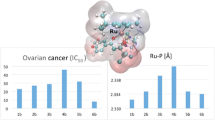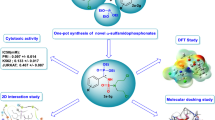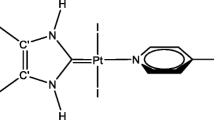Abstract
DFT computations were carried out to characterize the 17Oand 2H electric field gradient, EFG, in various bisphosphonate derivatives. The computations were performed at the B3LYP level with 6-311++G (d,P) standard basis set. Calculated EFG tensors were used to determine the 17O and 2H nuclear quadrupole coupling constant, χ and asymmetry parameter, η. For better understanding of the bonding and electronic structure of bisphosphonates, isotropic and anisotropic NMR chemical shieldings were calculated for the 13C, 17O and 31P nuclei using GIAO method for the optimized structure of intermediate bisphosphonates at B3LYP level of theory using 6-311++G (d, p) basis set. The results showed that various substituents have a strong effect on the nuclear quadrupole resonance (NQR) parameters (χ, η) of 17O in contrast with 2H NQR parameters. The NMR and NQR parameters were studied in order to find the correlation between electronic structure and the activity of the desired bisphosphonates. In addition, the effect of substitutions on the bisphosphonates polarity was investigated. Molecular polarity was determined via the DFT calculated dipole moment vectors and the results showed that substitution of bromine atom on the ring would increase the activity of bisphosphonates.

Similar content being viewed by others
References
Hewitt RE, Lissina A, Green AE, Slay ES, Price DA, Sewell AK (2005) Clin Exp Immunol 139:101–111
Neville-Webbe HL, Holen I, Coleman RE (2002) Cancer Treat Rev 28:305–319
Coleman RE (2001) Cancer Treat Rev 27:165–176
Coleman RE (2002) Semin Oncol 29:43–49
Boissier S, Magnetto S, Frappart L, Cuzin B, Ebetino FH, Delma PD, Clezardin P (1997) Cancer Res 57:3890–3894
Rosen LS, Gordon D, Tchekmedyian NS (2004) Cancer 100:2613–2621
Wilhelm M, Kunzmann V, Eckstein S, Reimer P, Weissinger F, Ruediger T, Tony HP (2003) Blood 102:200–206
Sanders JM, Ghosh S, Chan JM, Meints G, Wang H, Raker AM, Song Y, Colantino A, Burzynska A, Kafarski P, Morita CT, Oldfield E (2004) J Med Chem 47:375–384
Hayday AC (2000) Annu Rev Immunol 18:975–1026
Bendelac A (2001) Nat Rev Immunol 1:177–185
Girardi M, Oppenheim DE, Steele CR, Lewis JM, Glusac E, Filler R, Hobby P, Sutton B, Tigelaar ER, Hayday AC (2001) Science 294:605–609
Morita CT, Mariuzza RA, Brenner MB (2000) Springer Semin Immunopathol 22:191–217
Zhang Y, Leon A, Song Y, Studer D, Haase Ch, Koscielski LA, Oldfield E (2006) J Med Chem 49:5804–5814
Fritscher J (2004) Phys Chem Chem Phys 6:4950–4956
Nakamura N, Masui H, Ueda T (2000) Z Naturforsch 55a:315–322
Latosińska JN, Seliger J, Nogaj B (1999) Magn Reson Chem 37:878–880
Zhang Y, Oldfield E (2004) J Phys Chem B 108:19533–19540
Helgaker T, Jaszunski M, Ruud K (1999) Chem Rev 99:293–352
Perczel A, Csaszar AG (2000) J Comput Chem 21:882–900
Hameka HF (1963) Advanced quantum chemistry. Addison-Wesley, New York
Hui-ding X, Yu-peng L, Kai-xiong Q, Bo L, Ya-ping C (2010) Chem Res Chin Univ 26:1016–1019
Gauss J, Stanton JF (2002) In: Prigogine I, Rice SA (eds) Advances in chemical physics. Wiley, Chichester, pp 123–355
Casabianca LB, Dios AC (2008) J Chem Phys 128:052201–10
Frisch MJ et al (1998) Gaussian 98, Revision A7. Gaussian Inc, Pittsburgh
Becke AD (1993) J Chem Phys 98:5648–5652
Lee C, Yang W, Parr RG (1988) Phys Rev B 37:785–789
Wolinski K, Hinton JF, Pulay P (1990) J Am Chem Soc 112:P8251–8260
Daniel M, Jordan K, Maria M, Ioan A, Akash B, Kim Z, Erik RP (2007) Chem Phys Chem 8:1375–1385
Tossell JA, Paolo L (1986) J Phys B at Mol Phys 19:3217–3226
Pyykkö P (2001) Mol Phys 99:1617–1629
Garcia ME, Bennemann KH (1989) Phys Rev B 40:8809–8813
Karelson M, Lobanov VS, Katritzky AR (1996) Chem Rev 96:1027–1043
Mitchell KAR (1969) Chem Rev 89:157–178
Zhang Y, Hudock MP, Krysiak K, Cao R, Bergan K, Yin F, Leon A, Oldfield E (2007) J Med Chem 50:6067–6079
Author information
Authors and Affiliations
Corresponding author
Rights and permissions
About this article
Cite this article
Aghabozorg, H., Sohrabi, B., Mashkouri, S. et al. Ab initio DFT study of bisphosphonate derivatives as a drug for inhibition of cancer: NMR and NQR parameters. J Mol Model 18, 929–936 (2012). https://doi.org/10.1007/s00894-011-1114-4
Received:
Accepted:
Published:
Issue Date:
DOI: https://doi.org/10.1007/s00894-011-1114-4




